Birth of a son brings joy, birth of a daughter brings gloom
Ganga Devi Gautam from Tatopani in the north-western district of Jumla gave birth to four children, hoping one of them would be a son. Her family was unhappy that Gautam had not had a son—until she finally gave birth to one in her fifth attempt. When that happened, her family and neighbors, accompanied by a band, reached the hospital to celebrate the occasion. They also organized an abir jatra (a colorful procession) and a communal meal. Gautam’s family members started treating her better.
When word spread that Laxmi Raut from Thantikandh, a rural municipality in Dailekh, gave birth to a son, her family and relatives also went to the health center with a band. They also celebrated the occasion by doing an abir jatra, to the surprise of the health center’s staff.
These two are representative examples of gender discrimination. In Karnali Province (where both Jumla and Dailekh fall), girls are discriminated against right from the womb. Family and relatives do not celebrate the birth of a girl because of the entrenched belief that while a son takes care of the parents in old age, a daughter leaves home after marriage.
As a result, most couples face societal pressure to have a son, and women keep producing babies hoping they would finally give birth to a male child. Meanwhile, having so many babies wrecks women’s health.
Pushe Nepali, 65, from Tila rural municipality in Jumla got married when he was just 14. His wife gave birth to 11 daughters in the hope of having a son. Because of the dire financial situation of the household, it was difficult to raise 11 daughters, three of whom died. Says Pushe, “I wanted a son but ended up with many daughters. I regret it now.”
Because she did not give birth to a son, Jhan Maya Rokaya from Kanakasundari rural municipality in Jumla was thrown out of her house by her husband, who faced family pressure to do so. The Rokayas have six daughters together. Jhan Maya’s case is not atypical; most women in Karnali have to endure domestic violence if they do not give birth to a son.
Also on the rise in recent years are cases of female feticide, which is common even among educated folks. Latest statistics show that female birth rates have gone down in the provincial capital of Birendranagar. Local and provincial governments have introduced various schemes to check the trend. To encourage couples to have daughters, the provincial government has started opening a bank account in the name of all girls born in Karnali Province and depositing Rs 500 every month in their account for 20 years.
Khandachakra municipality in Kalikot, another district in the province, has started handing over a cash gift to couples who give birth to a daughter. Says municipality chief, Jasi Prasad Pandey, “We are facing the problem of a skewed sex ratio, so we have had to provide incentives for couples to have daughters. Any couple in the municipality giving birth to two daughters at most and undergoing sterilization will be given Rs one lakh in cash.”
Brace yourself for ear-splitting Silence
The path to the 8th Silence Festival is all paved. And this year, Nepal’s biggest metal music fiesta features a heavy line-up of international artists, including the legendary ‘Testament’ from the US. Slated for December 14 at Tangalwood, Kathmandu, the Silence Festival has already sold out the limited number of early bird tickets it issued. But the audience can still buy tickets priced Rs 2,500 at the door. It’s an all-day concert and with the limited audience capacity you might want to get to the venue early.
Here we bring you a compilation of the international artists scheduled to perform.
Testament is an American thrash metal band from Berkeley, California. Formed in 1982 under the name Legacy, the band's current lineup comprises guitarists Eric Peterson and Alex Skolnick, lead vocalist Chuck Billy, drummer Gene Hoglan, and bassist Steve Di Giorgio.
Since its inception, Testament has had numerous lineup changes, leaving Peterson as the only constant member. In 1986, Billy replaced original singer Steve “Zetro” Souza (who left the band to join Exodus as the replacement for Paul Baloff), just before recording their first studio album, “The Legacy,” and has been a member since.
Testament is credited as one of the most popular and influential bands of the thrash metal scene, as well as among the leaders of the second wave of the genre in the late 1980s. They have also been referred to as one of the “big eight” of thrash metal, along with Metallica, Megadeth, Slayer, Anthrax, Exodus, Overkill and Death Angel. The band has sold over 1.4 million albums in the US since the beginning of the SoundScan era and over 14 million worldwide. To date, Testament has released 12 studio albums (one of which is a collection of re-recorded songs), four live albums, five compilation albums, 12 singles and three DVDs.
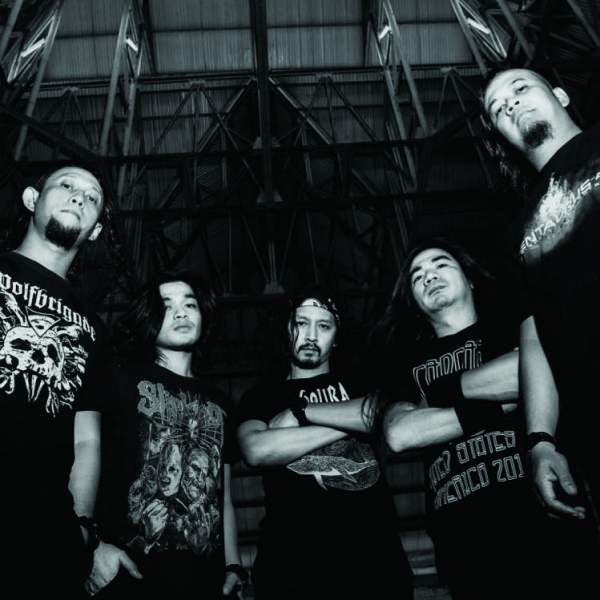
Burgerkill is an Indonesian metal band, originally from Bandung, the capital of West Java. Named after the fast food restaurant, Burger King, as a prank, the band was founded in May 1995 by Aris Tanto a.k.a. Eben, sometimes called ‘Ebenz’, then a young man from Jakarta who came to Bandung to continue his study. In Bandung, Ebenz met Ivan Scumbag, Kimung, and Dadan. These four comprised the first line-up of Burgerkill in 2013 and won Metal Hammer Golden Gods Awards in “Metal As F*ck” category.
Burgerkill was formed in Ujungberung region, located on the east side of Bandung city. Ujungberung is not only known as Metal Village, but also the center of Sundanese traditional art and culture, such as bela diri benjang, angklung, and kecapi suling.
Queso are a Filipino Rock band that enjoyed mainstream success in the late 1990s and early 2000s. The band eventually broke up after the release of their third album but reunited in 2012. At the height of their popularity, Queso (previously Cheese) were considered part of the Filipino Nu Metal genre. The band is best known for the single “Mottaka,” a song about friendship, from their second album “Pilipinas.”
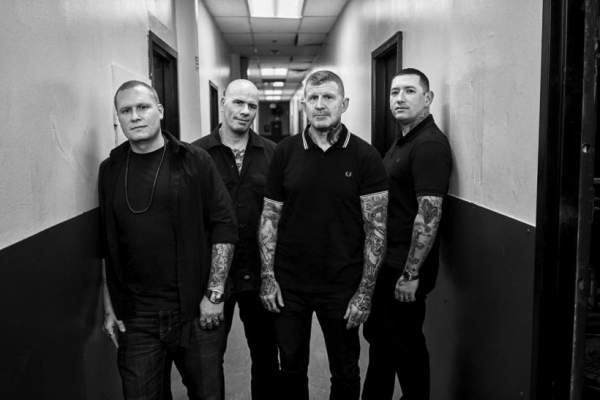
The band’s former and current members all grew up in the local rock and metal scene. The band’s singer Ian Tayao and guitarist Ocho Toleran each has background in other projects and with different artists. Queso’s sound, especially in their final years before disbanding, evolved and became more experimental, blending Rock, Reggae, Funk, Folk, Dub, and Jazz.
Trainwreck is an American southern and comedy rock band, formed in LA, California in 2002. It was founded by Tenacious D guitarist Kyle Gass and actor JR Reed. The band originally started out as a three-piece, with Reed on vocals, Gass on guitar and friend Kevin Weisman as the drummer. The band had pseudonyms for its members. Reed was “Darryl Lee Donald”, Gass was “Klip Calhoun” and Weisman was “Kenny Bob Thornton”. Gass and Reed began to search for backing musicians, as they felt Trainwreck’s musical style was “too close to Tenacious D”.
The band met electric guitarist John Konesky and bassist John Spiker in Ohio through a mutual friend. The two Ohio men relocated to Los Angeles to form Trainwreck as “John Bartholomew Shredman” and “Boy Johnny” respectively. Nate Rothacker replaced Weisman as the drummer in the mid-2000s, going under the pseudonym “Dallas St. Bernard”. The band released one studio album, one live album, one EP and a single before splitting in 2010. It would reform in 2018 and announce a reunion tour, as well as a second studio album.
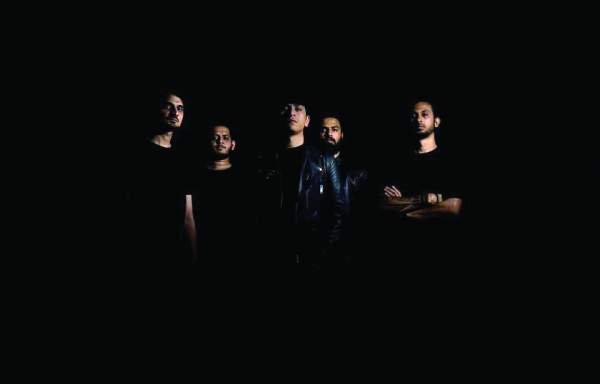
Godless slowly rose to the very top of India’s death metal class from their inauspicious origins in an exotic metal music scene. Interestingly, through this gradual but inexorable climb, the members band didn’t distinguish themselves so much for their innovations as for their unapologetic commitment to pure, unadulterated, lightning-fast, ear-shredding, thrash-influenced death metal.
Since their formation in mid-2015 by musicians who have been part of the Indian metal scene for years, the Hyderabad-based band has also broken into other old-school metallic forms.
Slowly developing their craft over the next year, singer Kaushal LS, guitarists Ravi Nidamarthy and Rohit Nair, bassist Abbas Razvi, and drummer Aniketh Yadav eventually recorded a four-track EP with the mission statement-like title of “Centuries of Decadence,” which was mixed and mastered by Joe Haley of Australian technical death metal band Psycroptic. After being brought under the Transcending Obscurity Records fold, Godless launched their EP in May 2016, which was met with rave reviews in media, including features in Rolling Stone India, Metal Hammer, Terrorizer, and XXL Rock.
NMB ‘Pre Approved Home Loan’ facility | Daraz 11.11 breaks records
NMB ‘Pre Approved Home Loan’ facility
NMB Bank has announced the launch of ‘NMB Pre Approved Home Loan’ facility. Customers vying for home loans can now have their loan limits approved prior to selecting the intended property. Approval of the required loan limit is based on an individual’s repayment capacity, without prior assessment of the collateral. “The loan facility intends to erase the dilemma customers face in ascertaining the loan limit, and facilitate in obtaining the most suitable option in property supplemented by their earnings,” a statement by the bank reads.
Daraz 11.11 breaks records
Daraz, Nepal’s biggest online marketplace, has successfully completed its much-awaited 11.11 campaign with record-breaking numbers. The celebration officially entered Nepal with Alibaba’s 2018 acquisition of Daraz. This year, the popular online shopping platform sold over 150,000 products during the sale out, of which 40 percent products have already been dispatched. Daraz saw orders from across the country covering more than 24 cities. On the day, Daraz engaged over 350,000 users, an increase of 75 percent compared to 2018. The Daraz website had a mammoth 5,233,344 page views during the sale.
Bangla connect
Even though—or perhaps because—the two are not contiguous neighbors, Nepal and Bangladesh have always had cordial relations. Nepalis fondly recall the establishment of SAARC in 1985 under the initiative of Bangladeshi President Zihaur Rahman and King Birendra. Nepal and Bangladesh share the same vision for South Asia: a more integrated region that can better tackle common problems like poverty, disease, illiteracy, and big-power rivalry.
It’s a pity that the two countries with just 27 km separating them don’t trade and engage more with each other. According to the World Bank, in 2017 Bangladesh was Nepal’s ninth biggest trade partner, accounting for 1.3 percent of its trade. Nepal in fact trades more with Turkey (6.4 percent of its trade) and Italy (1.6 percent). This again highlights a shocking lack of connectivity in South Asia, which remains among the least integrated regions in the world. Bangladesh and Nepal, two of the fastest growing economies in South Asia, have every incentive to engage more with each other.
The Nepal visit of Bangladeshi President Mohammad Abdul Hamid is thus timely. True, he is only a ceremonial president. Yet he is also a towering figure in Bangladeshi politics whose words carry weight. During his Nepal visit, no concrete agreements were signed. It made sense, too, as it was a ‘confidence-building’ trip. We can expect more substantive agreements between the two countries in the days ahead, capitalizing on Hamid’s commitment to improve his country’s land, water and air connectivity with Nepal.
Bangladesh is keen to invest in hydropower in Nepal and buy the electricity thus produced. If Nepal can supply, it could import up to 9,000 MW to power its booming economy and replace its dirty coal and diesel-powered plants. Hamid also expressed an interest in linking the two countries’ river systems to boost water trade. As importantly for Nepal, Bangladesh is the gateway to the lucrative Southeast Asian markets. But for there to be any significant headway in Nepal-Bangla ties, the consent and goodwill of India, which controls the intervening territory, is indispensable.
Nepal-India ties have been rocked by the Kalapani dispute. But in the long run India, Bangladesh, Nepal and every other country in the region have no option but to cooperate to tackle common cross-border challenges like poverty, climate change and terrorism. Just as well. The more the countries talk and trade, the less they are likely to fight.
More than numbers
After nearly 20 months in office, the two-third KP Oli government is widely seen as having failed to deliver on its electoral promise of ‘Prosperous Nepal, Happy Nepalis’. People think the country has become less safe and more corrupt in this time. Top government officials have given a dismal account of themselves, both personally and in their roles as civil servants. Restrictions on free speech have increased too. On the other hand, the government is acknowledged as doing relatively better in foreign relations. But should we also start crediting it for its handling of the economy?
There have been some positive signs. Nepal this year leapfrogged 16 places, to 94th from last year’s 110th (among 194 countries), in the World Bank’s latest (ease of ) Doing Business Index. Last year, it had slipped five places. Potential investors around the world will hopefully take note. A week earlier, the same bank had forecast Nepal’s economy to grow by an average of 6.5 percent this year, behind only Bangladesh (7.2 percent) and India (6.9 percent) in South Asia. A growing service sector, reliable electricity, easier construction permits—all contribute to this better-than average growth.
But if things are fairly rosy, why is foreign investment at a historical low? Why are the country’s vital infrastructures still woeful? And what is contributing to the continued public gloom? One reason could be the high expectation with this government. The Oli government, perhaps unintentionally, gives off the vibe that its policies enrich only vested interests close to ruling parties. Moreover, the economic progress on paper, as reflected in the latest Doing Business Index, has yet to be realized. Finance Minister Yubaraj Khatiwada recently pointed out how even noted businessmen were unaware of recent helpful regulatory reforms. This lays bare the lack of communication between the government and other private and foreign stakeholders.
The government may contend that its investments in vulnerable sections of the society like the poor and the elderly have gone largely unnoticed in the Kathmandu-centric media obsessed with hard numbers. Nor, as PM Oli repeatedly points out, is its laying of the ‘groundwork’ for an expected ‘economic take-off ’ readily apparent. Just wait a few more years, he reassures us. We wait with bated breath, comrade!
It's time to
HIKE
IN SUNDARIJAL
For hiking enthusiasts who want to travel in Nepal, Sundarijal, an hour’s drive from Lagankhel, is a not-to-miss destination. Sundarijal, which means “beautiful water”, is about 17 kilometers away from Kathmandu, and renowned for its majestic waterfalls and green villages. Sundarijal is especially famous among young local travelers who go there to hike, swim, picnic, and bike-riding. Makes for a great weekend getaway!
LISTEN TO JAZZ MUSIC
IN KATHMANDU

Are you a fan of jazz, a music genre which has its roots in blues and ragtime? Jazz Upstairs, a jazz and blues club in Lazimpat, hosts “Modern Jazz Mondays with Alessio Cazzetta Trio” every Monday from 8 pm to 10 pm. You can enjoy food and beverages available at the club with live modern jazz music. With Alessio Cazzetta on guitar, Sulav Maharzan on bass and Kiran Shahi on drums, you are sure to have a groovy night. Call 01-4416983 for more details.
BAKE A CAKE
IN POKHARA

Have you ever baked a cake? This might seem daunting at first, but with patience and some guidance, a moist, fluffy cake is only a few hours away. If you think it’s too complicated, worry not! With Rs 3,500, you can take Rekha’s cooking class in Pokhara. The cost covers all ingredients needed to make a cake. Book through i-likelocal.com.
Judgment day
It’s incredible how the political parties that promulgated the new constitution, hailing it as among the ‘best in the world’, have been so disinterested in implementing it. These include the parties now running the federal government, as well as the main opposition. The seventh constitution of democratic Nepal was also the most revolutionary: for the first time people had written their own charter. It was also the constitution that cemented Nepal’s new federal status, marking a decisive break in the country’s 250-year-old history as a unitary state.
The old structure had proven incapable of delegating power and responsibilities down to the grassroots. Without this kind of devolution, it was hard to see the country develop and its people politically and economically empowered. The new constitution provided for three tiers of government: federal, provincial and local. The idea was that the provincial and local governments would act with a high degree of autonomy, and with direct participation of the people at the grassroots. For this they would get enough support from Kathmandu, the federal capital.
Yet the old unitary mindset has been hard to change. The federal officials have been most reluctant to devolve powers. All the important decisions continue to be made in Kathmandu and imposed on the seven provinces and the 753 local units. Shamefully, over 70 percent of the federal budget goes to the federal government, with the rest divided among the local and provincial governments. As the lower level governments are without even basic infrastructure and manpower, this allocation is inadequate—and unjust.
This is an example of the deep chasm between the high aims of the new constitution and their realization. Old unitary demarcations remain, as do the unitary officialdom that often competes for influence with the new provincial and local officials. Despite an overwhelming mandate, the federal government has been unable to make any headway in improving the economy or ensuring that people’s lives and properties are protected. Nor do the historically disadvantaged minorities feel the new charter, or its custodians, work in their interests. The government would do well to pay heed to their legitimate grievances so as to broaden the constitution’s ownership.
As public dissatisfaction mounts, federalism is being blamed for everything wrong in the country of late. But it’s more a case of our political leadership and top bureaucrats refusing to shed their old unitary lens and to transcend self-interest. On this fourth anniversary of the new constitution, its promulgators need to do some soul-searching. Otherwise, the new edifice they are building on it could come crashing down.
PJ Club’s photo contest winners on display
This yearly signature event of the Photojournalist Club, this year titled “Literacy and Multilingualism photo contest,” received 636 submissions from 182 photographers. If you go to Nepal Art Council, Babarmahal you will see the best 54 photographs that highlight the essence of learning and teaching experiences in the multilingual settings of Nepal. On September 8, three best photographs and two honorary mentions were given cash prizes.
Pankaj Shrestha bagged the first prize. His photo “Help begins with understanding” shows a teacher helping an autism affected boy learn in classroom. Sunita Dangol got the second prize with her photo of the living goddess Kumari getting private lessons at home. The photo of Anish Regmi, which won the third prize, shows deaf students communicate in sign language.
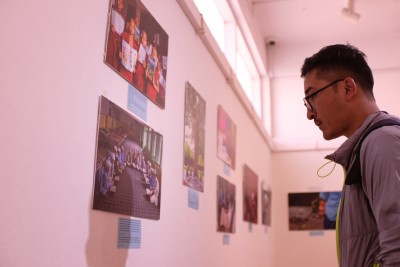
Photo Mahendra Khadaka
Bhanu Roshan Rajbhandari, an advocate, who had come to see the exhibit, says the photos give him mixed feelings. “As beautiful as the photos are, they also hide much pain,” he says. He adds that these photos make it clear how far our education system still has to go. Till now, students have to sit on mats or beside rivers to study. “These photos make me question where all the investment in education is going,” he says.
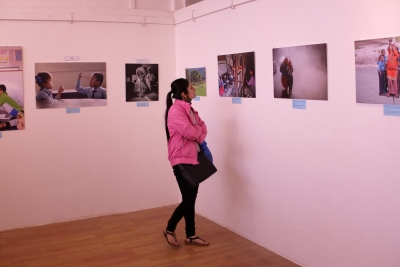
Photo Mahendra Khadaka
The exhibition is aimed at promoting social cohesion and providing a platform to bring better understanding of effective learning in our diverse environment. Anyone interested in photography or in the state of education in Nepal should consider visiting the exhibition which runs till September 14.














